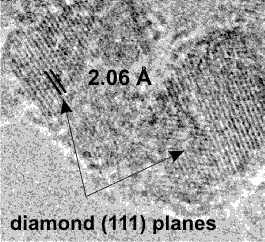Detonation nanodiamond
Nanodiamond (ND) forms part of the carbon nanomaterial family which, along with fullerenes and nanotubes, has attracted great interest in recent years due to its unique physical and chemical properites. Early studies on nanodiamond were rooted in defence and weapons research but now reach into a variety of fields such as medicine and astrochemistry.

HRTEM micrograph of initial detonation nanodiamond material showing the (111) crystalline spacings.
Nanodiamond is one of the few nanomaterials to be produced at commerical scales which stems from the production technologies developed in the 1960s. As its name suggests, it is synthsized by the detonation of solid explosives in an inert atmosphere. Nanodiamond crystallites are characterized by a narrow size distribution: most particles lie between 2 and 20 nm in diameter with average particle sizes of ~ 4 - 5 nm.
Current research activites in the Group are directed towards the functionalization and surface modification of ND particles for specialist applications. Recent research has applied surface hydrogen treatment to remove the suface graphitic layers from ND crystals annealled at high temperatures.
Our Publications
- Butenko Yu V, Coxon PR, Yeganeh M, Brieva AC, Liddell K, Dhanak VR and Šiller L
Stability of hydrogenated nanodiamonds under extreme ultraviolet irradiation
DIAMOND AND RELATED MATERIALS 17 (6): 962-966 MAR 2008 - Yeganeh M, Coxon PR, Brieva AC, et al.
Atomic hydrogen treatment of nanodiamond powder studied with photoemission spectroscopy
PHYSICAL REVIEW B 75 (15): Art. No. 155404 APR 2007

